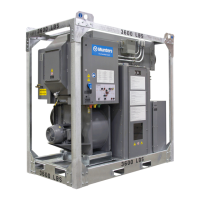Manual# I27028 6-4 Rev. 2 – 11/22/2017
The wheel assembly is heavy, particularly if it is wet. Use a
helper when lifting the HoneyCombe
®
wheel. It is safe to roll the
wheel.
7. To replace the wheel, reverse the steps listed above. It is easiest to work from the
rear of the unit. Roll the new wheel carefully into position in the center of the
machine.
The wheel includes a metal cam. When viewed from the rear of the machine, this
cam should be closest to the left side (process inlet) of the unit. When viewed from
the front of the machine (drive assembly side), the cam should be closest to the
right side of the machine.
Work carefully to not damage the seals. Do not seat the wheel against the front
roller yet.
8. Go to the front of the machine. Slip the end of the drive chain over the end of the
shaft for the front wheels. Replace the right end of the shaft in the supporting hole.
Move the left-hand collar into position and tighten the set screw. Allow a small
amount of side-to-side play on the shaft.
9. For the R05 - lift the front of the motor again, and place the drive chain over the
drive sprocket. Allow the drive motor to drop. In belt drive systems, the belt should
be aligned with its drive sheave.
10. Ensure the chain is accurately seated on all the sprocket teeth around the wheel
circumference
11. Replace the access panels. The unit is now ready to operate.
12. Make a quick check of the airflows and operating temperatures as the machine
runs.
13. The new wheel may behave slightly differently from the old one.
6.6 INSPECTING THE HONEYCOMBE
®
WHEEL
The HoneyCombe
®
wheel contains a lightweight framework which supports the desiccant
chemical. This framework is manufactured in a shape which looks like the honeycomb in
a bee hive. The honeycomb pattern includes many small air passages or “flutes” which
run through the wheel. These passages are designed to allow air to flow across the
desiccant chemical with the least amount of resistance.
Near the seam in the wheel housing there is some engraved text. The text includes the
wheel serial number, the date of manufacture, and the manufacturing process used. The
following table will help to identify the type of desiccant chemical used in the wheel.
Wheel Chemical Color Marking
Titanium enhanced silica gel Red Tigel
The HoneyCombe
®
wheel will generally not foul or plug up unless one of the air streams
has not been properly filtered. Plugging is most likely to happen when a unit must
operate in a very dusty environment. Problems can be minimized by regular
maintenance of the prefilters. If the wheel becomes blocked, this will increase the
pressure drop across the wheel for both the process and the reactivation air streams.

